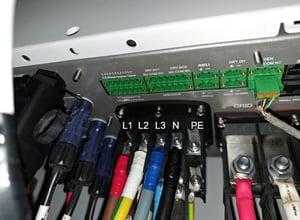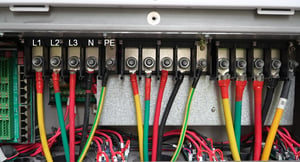
Häufig gestellte Fragen
Haben Sie Fragen? Wir sind hier um zu helfen
Das geht nicht.
Der Dieselgenerator muss an den speziellen Anschluss für den Dieselgenerator angeschlossen werden, da das System sonst nicht erkennen kann, ob es sich um den Dieselgenerator oder das Netz handelt und somit nicht richtig funktioniert. Die Spannungswellenform des Dieselgenerators ist relativ schlecht. Wenn er an den Netzanschluss angeschlossen wird, kann er vom System als anormaler Eingang erkannt werden und kann nicht gestartet werden.
Der einzige Generator Port der europäischen Version:

Der einzige Generator Port der Pro-Version:

Bei Microgrid-Systemen werden häufig Dieselgeneratoren für die Stromversorgung von CHS2 verwendet. Die Kunden müssen den Dieselgeneratorausgang oft gleichzeitig an die Backup-Last anschließen, damit die Last direkt mit Strom versorgt werden kann, wenn CHS2 eine Störung aufweist. Die folgende Anschlussmethode ist nicht zulässig. Wenn CHS2 durch Rückfluss beschädigt wird, übernimmt unser Unternehmen keine Garantie.

Selbst wenn der Kunde ein ATS als Schalter in die Schleife einfügt, ist es sehr wahrscheinlich, dass das ATS durch Spannungsrückfluss beschädigt wird, wenn auf beiden Seiten Strom anliegt.
Wenn der Kunde einen Wartungskreislauf hinzufügen muss, wird empfohlen, einen MCB und einen manuell gesteuerten ATS hinzuzufügen, um sicherzustellen, dass der Wartungskreislauf nur gestartet wird, wenn der CHS2 abgeschaltet ist, und somit die Sicherheit der CHS2-Ausrüstung zu gewährleisten.

Der Lade- und Entladestatus der Batterie von CHS2 wird nicht vollständig durch den Netzstatus bestimmt. Ob das System die Batterie auflädt oder ob sie mit dem Netz geladen werden kann, wird durch die Betriebsplanungsstrategie bestimmt.
In der Betriebsplanungsstrategie kann der Benutzer den Ladezeitraum, den Entladezeitraum und den Standby-Zeitraum usw. festlegen. Befindet sich das System im Standby- oder Entladezeitraum, wird die Batterie nicht geladen, auch wenn das Netz verfügbar ist.
Die Klappe des Batterieschranks kann während des Betriebs des Geräts nicht geöffnet werden. Sie kann nur geöffnet werden, wenn das Gerät zu Wartungszwecken abgeschaltet ist.
Wenn das Gerät in Betrieb ist und die Klappe des Batterieschranks geöffnet wird, wird dies als Systemanomalie betrachtet, die Batterie schaltet sich ab und die Systemleistung wird unterbrochen.
Es wird empfohlen, die Schranktür nur bei Bedarf zu öffnen.
Zusätzlich zur Gesamtlastüberlastung kann das System auch aufgrund einer einphasigen Überlastung abgeschaltet werden. Wenn die einphasige Last die Lastspezifikation überschreitet, wird das System ebenfalls aufgrund von Überlast abgeschaltet. Die maximale einphasige Lastspezifikation des CHS2 beträgt 18KW. Wenn die Gesamtlast einer Phase diesen Wert überschreitet, wird das System aufgrund von Überlast abgeschaltet, auch wenn die Gesamtlast 50KW nicht überschreitet.
Unter normalen Umständen sollte die Batterie nach einem Netzausfall entladen werden, um die Last kontinuierlich mit Strom zu versorgen.
Wenn die Last nach einem Netzausfall Strom verliert, müssen die folgenden Fragen geklärt werden:
1. Prüfen Sie zunächst, ob die Last an den Backup-Port angeschlossen ist. Nur die an den Backup-Port angeschlossene Last liefert nach einem Netzausfall weiterhin Ersatzstrom.
2. Ist die Batteriekapazität normal, bevor die Netzstromversorgung unterbrochen wird? Wenn die Batteriekapazität dauerhaft sehr niedrig ist und sich nahe der Untergrenze der Niederspannung befindet, kann sie nach der Netzunterbrechung keine Leistung mehr erbringen.
Die dreiphasige AC-Eingangsspannung des CHS2 muss in einem Winkel von 120 Grad aufeinander folgen. Wenn es ein Problem mit der Verdrahtung gibt, wird ein Alarm für Phasenfolgefehler ausgegeben.
Die folgenden Maßnahmen sind erforderlich:
1. Überprüfen Sie die Verdrahtung der Eingangsstromleitung, um festzustellen, ob es ein Problem mit der Kabelfarbe gibt, das eine Umkehrung der Phasenfolge verursacht.
2. Wenn die Reihenfolge der Kabelfarben korrekt ist, empfiehlt es sich, sie mit einem Phasenfolge-Messgerät zu überprüfen. Wenn kein Phasenfolge-Messgerät vorhanden ist, können Sie die korrekte Phasenfolge mit der Kreuzmethode überprüfen.
Wenn CHS2 wegen geringer Entladekapazität abgeschaltet wird, erfolgt die Abschaltung nicht vollständig entsprechend der Kapazität des gesamten parallelen Systems; solange die Kapazität eines CHS2 im System unter dem Grenzwert liegt, wird die Abschaltung wegen geringer Entladekapazität ausgeführt.
CHS2 gleicht die Ausgänge jedes Systems beim Entladen aus, aber es kann eine Situation eintreten, in der die Lücke zu groß ist oder die Kapazität eines Geräts zu niedrig ist und zuerst auslöst.
Wenn der CHS2 während des Betriebs plötzlich an Leistung verliert und niedrige Batteriekapazität und Überlast ausgeschlossen sind, ist die wahrscheinlichste Ursache ein plötzlicher Anstieg der induktiven Last.
Wenn mehr als 20 % der CHS2-Lasten induktive Lasten sind (hauptsächlich Motoren oder Stoßlasten), ist die Wahrscheinlichkeit groß, dass der momentane Stoßstrom zu groß ist und das System ausfällt. In diesem Fall ist die nächste Aktion ein System-Reset mit einem anormalen Alarm, wie z. B. PV-Überstrom.
Nachdem CHS2 an den Dieselgenerator angeschlossen ist, kann der Start des Ölmotors manuell über CHS2 gesteuert werden.
Wenn der Kunde den Dieselgenerator starten muss, ist der manuelle Betrieb nicht direkt über die Schnittstelle des Dieselgenerators erlaubt. Er muss über die APP-Schnittstelle des Elefantenhalters bedient werden, den Betriebszustand des Dieselgenerators von CHS2 auf manuell ändern und dann starten oder abschalten.
Die APP steuert manuell das Starten und Stoppen des Dieselgenerators. Es wird generell empfohlen, sie nur während der Inbetriebnahmephase zu verwenden. Nachdem das System normal läuft, schalten Sie bitte sofort in den automatischen Steuerungsmodus um.
Um den Dieselgenerator ohne APP-Betrieb zu starten, vergewissern Sie sich, dass sich CHS2 im Abschaltzustand befindet.
Die PV-Anlage begann zu arbeiten, während der Dieselgenerator in Betrieb war, aber der Dieselgenerator hörte nicht auf zu arbeiten. Dies liegt daran, dass die Bedingung für die Abschaltung des Dieselgenerators darin besteht, dass der SOC der Batterie den Grenzwert erreicht. Der Dieselgenerator muss die Batterie bis zum Grenzwert aufladen, bevor der Dieselgenerator natürlich abschaltet. Die PV-Ladung steht in keinem Zusammenhang mit dem Betriebszustand des Dieselgenerators. Wenn der Kunde der Meinung ist, dass die PV-Energie verschwendet werden könnte, empfiehlt es sich, den SOC-Grenzwert auf einen kleineren Wert einzustellen.
Nach dem Einschalten des CHS2 erscheint, solange die PV-Anlage oder die Batterie mit Strom versorgt wird, eine Anzeige auf dem Wechselrichterpanel. Wenn Sie nichts sehen können, überprüfen Sie bitte, ob das Licht auf der Vorderseite des Wechselrichter-Panels zu hell ist und das Sonnenlicht stark reflektiert wird, was zu unklarer Sicht führt.
Wenn dieser Grund ausgeschlossen werden kann, wird empfohlen, das Wechselrichter-Panel nach dem Abschalten zu öffnen und zu prüfen, ob das LED-Kommunikationskabel abgeklemmt ist.
Ein Phasenausfall ist eine der Anomalien des Stromnetzes. Das Energiespeichersystem ist nicht in der Lage, Strom aus dem Netz zum Aufladen zu beziehen. Zu diesem Zeitpunkt wird es in den netzunabhängigen Zustand versetzt. Wenn die Last des Kunden an den Backup-Anschluss angeschlossen ist, wird er weiterhin Strom an die Last abgeben. Wenn die Last des Kunden nicht an den Backup-Anschluss angeschlossen ist, kann das Gerät keine normale dreiphasige Stromversorgung liefern.
Die geringe photovoltaische Stromerzeugung ist meist auf die Photovoltaikmodule zurückzuführen. Mögliche Gründe sind: das Photovoltaikmodul ist blockiert, die Oberfläche wird nicht rechtzeitig gereinigt, was zu viel Staub verursacht, die Ausrichtung des Photovoltaikmoduls ist unterschiedlich, und der Trommeleffekt wird durch heiße Stellen oder Schäden an den Modulen verursacht; es ist auch notwendig, die Verkabelung zu überprüfen, ob es Probleme gibt, wie z. B. inkonsistente Stringlängen oder Module mit unterschiedlichen Ausrichtungen, die an denselben String angeschlossen sind.
Wenn die oben genannten Gründe ausgeschlossen sind, überprüfen Sie bitte die Leistungsbegrenzung des PV-Wechselrichters, um festzustellen, ob diese die Ausgangsleistung des Wechselrichters begrenzt. Wenn ja, erhöhen Sie bitte die Leistungsgrenze.
Systemüberspannung bedeutet, dass die Netzspannung des Wechselrichters zu hoch ist und den Alarmgrenzwert überschreitet. Die Hauptgründe dafür sind: 1. Die Spannung des Netzes selbst ist zu hoch, d.h. der vom Transformator ausgegebene Spannungswert ist ursprünglich hoch. Um die normale Stromversorgung weit entfernter Gebiete zu gewährleisten, wird in der Regel die Spannung des Transformators erhöht, was zu einem Anstieg der gesamten Netzspannung führt. 2. Schwacher Netzeffekt. Da das Kabel relativ weit vom Transformator entfernt ist, ist der Spannungsabfall im Kabel insgesamt zu groß, was zu einem Anstieg der Spannung auf der Wechselrichterseite führt. Die Lösung besteht darin, einen Energiespeicher hinzuzufügen oder die Ausgangsleistung des Wechselrichters zu verringern, den Stromwert der an das Netz gesendeten Leistung zu reduzieren, den Spannungsabfall im Netz zu verringern und somit die Wechselrichterspannung zu senken.
Die abnormale Kommunikation des Messgeräts wird dadurch verursacht, dass der CHS2 das Messgerät während des Betriebs nicht erkennen kann. Es ist zu prüfen, ob die RS485-Verbindung des Messgeräts normal ist, ob die Leitung lose ist oder das Kabel des Steckers gebrochen ist.
Die Last verliert Strom, wenn das Netz ausfällt. Der Hauptgrund dafür ist, dass die Last nicht an den Backup-Anschluss des CHS2 angeschlossen ist. Nach einem Netzausfall kann der Backup-Anschluss des CHS2 weiterhin Strom ausgeben und eine kontinuierliche Stromversorgung gewährleisten. Wenn er nicht mit dem Backup-Anschluss verbunden ist, kann er die Stromversorgung nicht aufrechterhalten.
Darüber hinaus gibt es im Betriebsmodus des Dieselgenerators, nachdem der Dieselgenerator seinen Betrieb eingestellt hat, in der Mitte eine kurze Ausfallzeit, wenn er vom Dieselgeneratorzustand in den netzunabhängigen Ausgangszustand übergeht. Da der Betriebszustand des Dieselgenerators netzunabhängig ist, dauert die Umstellung vom netzunabhängigen Zustand auf den Wechselrichterzustand etwa 60 Sekunden.
Wenn der Schalter während der Netzverbindung nicht leuchtet, vergewissern Sie sich zunächst, dass das EMS normal mit Strom versorgt wird; prüfen Sie dann, ob das Netzwerkkabel richtig angeschlossen ist, ob es vom LAN-Anschluss des CHS2 an den Schalter angeschlossen ist, und prüfen Sie dann, ob der Netzwerkanschluss nicht fest oder lose angeschlossen ist. Wenn diese beiden Probleme behoben sind, tauschen Sie bitte das Netzwerkkabel aus und versuchen Sie es erneut.
